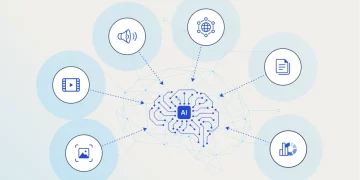The banking industry is undergoing a transformative shift as Artificial Intelligence (AI) plays an increasingly significant role in reshaping its core operations. AI has disrupted traditional banking practices by improving fraud detection, enhancing personalization, and revolutionizing financial planning. As financial institutions continue to integrate AI into their processes, they are learning valuable lessons that allow them to refine their approach, deliver better services, and respond more effectively to emerging challenges.
In this article, we will explore how AI is being used in the banking sector, focusing on key areas such as fraud detection, personalized banking experiences, and financial planning, and analyze the lessons learned along the way.
1. Fraud Detection: Enhancing Security and Reducing Risk
Fraud has always been a major concern for banks, affecting not only their financial bottom line but also the trust of their customers. As cybercriminals become more sophisticated, traditional fraud detection systems often fail to keep up with the sheer volume and complexity of fraudulent activities. AI, however, is revolutionizing fraud detection by providing more proactive and accurate methods for identifying potential threats in real-time.
AI-Powered Fraud Detection Systems
AI algorithms can process vast amounts of transactional data and detect patterns that human analysts might miss. Machine learning models, specifically supervised learning algorithms, are trained on historical data to recognize fraudulent behavior by analyzing anomalies and flagging suspicious transactions. By continuously learning from new data, AI-powered systems can improve their accuracy and identify fraud more effectively.
One major lesson the banking sector has learned from integrating AI for fraud detection is the importance of real-time monitoring. Banks have realized that fraud often occurs in microseconds, and AI allows them to detect suspicious activity as soon as it happens. For instance, AI tools can instantly detect unusual behavior, such as a sudden large transaction or a withdrawal from a foreign country, and automatically flag the transaction for further investigation or temporarily freeze the account to prevent further damage.
HSBC, for example, has leveraged AI to strengthen its fraud detection system. The bank’s AI solution analyzes millions of transactions daily to spot patterns that indicate potential fraud, whether it’s through credit card fraud, money laundering, or identity theft. By using machine learning, HSBC has not only been able to prevent fraudulent activity more effectively but has also learned to fine-tune its system to reduce false positives, which improves customer experience.
Predictive Analytics and Risk Assessment
Another key lesson is the importance of predictive analytics in fraud prevention. AI’s ability to predict future fraudulent activities based on historical data is a game-changer. With predictive models, banks can proactively identify risks and take preventative actions before they escalate. AI tools can analyze customer behaviors, such as spending habits and transaction history, to develop a profile of typical behavior. When a transaction deviates from this established pattern, AI can flag it as suspicious, offering banks the chance to stop potential fraud before it affects the institution.
2. Personalization: Enhancing Customer Experiences
Personalized banking is an area where AI has had a profound impact, transforming the way financial services are delivered to customers. Traditional banking systems offered standardized services, with little regard for individual customer needs. Today, AI enables banks to provide highly tailored products and services, improving customer satisfaction and loyalty.
AI-Driven Customer Insights
AI-powered data analytics and machine learning models can analyze vast amounts of customer data to generate personalized insights. By examining transactional history, spending habits, financial goals, and demographic data, AI systems can suggest the most relevant products, services, and financial advice. This level of personalization allows banks to deliver services that align with individual needs and preferences, enhancing the customer experience and fostering long-term relationships.
For example, Bank of America uses its virtual assistant, Erica, which is powered by AI to offer personalized financial advice to its customers. Erica helps customers with everything from budgeting and setting financial goals to managing investments and analyzing spending patterns. This personalized approach not only provides value to the customer but also enables the bank to better understand individual behaviors and anticipate future needs.
Targeted Marketing and Customer Retention
AI has also transformed the way banks approach marketing and customer retention. By using machine learning algorithms, banks can segment their customers more accurately and create targeted marketing campaigns that resonate with individual customers. This can range from sending personalized offers based on spending habits to recommending products that align with a customer’s current life stage or financial goals.
CitiGroup is an excellent example of how AI has been used to enhance personalized marketing efforts. By leveraging AI-driven analytics, CitiGroup can send tailored offers and services to customers at the right time, improving the effectiveness of their marketing campaigns. Additionally, AI helps the bank to anticipate customer needs, making it more likely to retain existing clients and reduce churn rates.

3. AI in Financial Planning: Revolutionizing Wealth Management
AI has also proven to be an invaluable tool in financial planning and wealth management, areas traditionally handled by human financial advisors. By integrating AI, banks have made financial planning more accessible, efficient, and personalized for customers of all income levels.
Robo-Advisors: Democratizing Financial Planning
Robo-advisors are AI-powered platforms that provide automated, algorithm-driven financial advice with minimal human intervention. These platforms analyze a customer’s financial situation, investment goals, risk tolerance, and preferences to recommend a tailored investment portfolio. This has democratized financial advice by making it available to a broader audience, including individuals who might not have the resources to afford traditional human financial advisors.
Betterment and Wealthfront are leading examples of robo-advisors that use AI to create personalized financial plans. These platforms utilize AI to automatically adjust investment portfolios based on changes in the market or a client’s financial situation, ensuring that the investments remain aligned with their goals.
One of the key lessons the banking sector has learned from the integration of robo-advisors is that AI can offer more objective, data-driven recommendations. Unlike human advisors, AI doesn’t have emotional biases or conflicts of interest, and its decisions are based purely on algorithms and data analysis. This has made financial planning more transparent and fair for consumers, especially those who are just starting to build wealth.
AI in Risk Assessment and Portfolio Management
AI also plays a vital role in assessing risk and managing investment portfolios. AI tools can analyze historical market data and identify patterns that human analysts might miss. By continuously monitoring market trends, AI can recommend adjustments to portfolios to optimize performance and minimize risk.
For instance, JPMorgan Chase uses AI in its COiN platform to analyze legal documents and market data to make smarter investment decisions. The platform helps JPMorgan’s investment managers gain insights into potential risks and opportunities, leading to more effective and dynamic portfolio management.
Banks are learning that AI can help enhance the accuracy of financial planning by considering a wider array of factors and by responding to changes in real-time, which traditional financial planners might struggle to do.
4. AI and Regulatory Compliance: Streamlining Operations
With the increasing complexity of global financial regulations, banks face mounting pressure to comply with regulatory requirements. AI has emerged as a powerful tool to help banks streamline their compliance processes, reduce costs, and avoid regulatory penalties.
Automating Compliance Monitoring
AI can help banks monitor and ensure compliance by automating the detection of suspicious transactions, analyzing patterns in customer data, and ensuring that banks adhere to local and international regulations. AI systems can continuously scan transactions and records to detect any signs of non-compliance, such as money laundering or tax evasion.
Standard Chartered has integrated AI into its compliance processes, using machine learning models to monitor customer transactions and flag any suspicious activity that might indicate financial crimes. This approach not only improves the efficiency of compliance operations but also reduces human error and helps banks stay ahead of increasingly complex regulatory requirements.
5. Key Lessons Learned from AI Integration in Banking
As banks continue to embrace AI, they have learned several key lessons that help them refine their integration strategies:
- AI Requires Continuous Learning: AI systems are not static; they need to be constantly trained and updated with new data to remain accurate and effective. Banks must invest in ongoing training and model refinement to ensure their AI systems continue to deliver value.
- Customer Trust is Crucial: As banks use AI to personalize services and detect fraud, maintaining customer trust is essential. Clear communication about how AI is being used, ensuring data privacy, and offering transparency in decision-making are critical for customer acceptance.
- Collaboration with Human Experts: While AI can automate many processes, human expertise is still vital for making complex decisions, especially in areas like wealth management. The best results come from a hybrid approach that combines the efficiency of AI with the insights of human professionals.
- Scalability is Key: As banks grow, their AI systems must be able to scale efficiently. This requires investing in robust, flexible AI platforms that can handle increasing amounts of data and complexity without compromising performance.
Conclusion
AI’s integration into the banking sector has proven to be a powerful force for improving fraud detection, personalizing customer experiences, and enhancing financial planning services. Banks have learned that AI can help them deliver better services, improve efficiency, and stay competitive in an increasingly digital world. However, the key to successful AI integration lies in continuous learning, customer trust, and collaboration between humans and machines.
As the banking sector continues to embrace AI technologies, it is likely that the lessons learned in fraud prevention, personalization, and financial planning will inspire new innovations that further enhance the industry’s ability to serve its customers and adapt to future challenges.











































